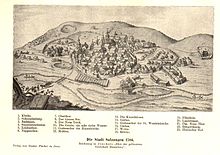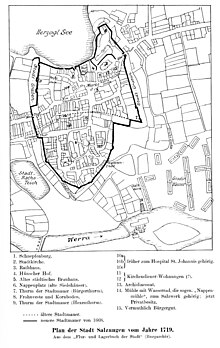Schnepfenburg (Bad Salzungen)
| Schnepfenburg | ||
|---|---|---|
|
Remnants of the wall over the castle lake |
||
| Castle type : | Location | |
| Conservation status: | Parts of the basement received | |
| Place: | bad Salzungen | |
| Geographical location | 50 ° 48 '42.5 " N , 10 ° 14' 4.1" O | |
| Height: | 255 m above sea level NN | |
|
|
||
The Schnepf castle was in the middle ages built castle in the town of Bad Salzungen in Wartburgkreis in Thuringia .
location
As a city castle , the complex was located on the southern edge of the old town, the castle hill rises about 15 to 20 meters above the level of the castle lake . The castle protected the access to the city and the Salzunger saltworks.
history
In the Middle Ages, Salzungen was an important salt pans and junction in the network of Hessian-Thuringian highways. Already in prehistoric times the Celts discovered a salty spring not far from the castle hill and founded a fortified settlement for salt extraction. During excavations on the castle hill, cultural layers from the subsequent settlement phases up to the late Middle Ages were also found. More fortifications were probably built by the Franks. This castle complex was founded around 1160 under the Fulda Monastery and equipped with military equipment. It was first mentioned in 1166. The castle complex was later included in the city fortifications and formed the south-western bulwark. The Burgmannen were obliged to build residences within the city, including the Haunscher Hof . The name of the castle is initially not mentioned in the city chronicle, only the discovery of a document in the container at the top of the tower revealed the name, there is talk of the "insurmountable Schnepfenburg". The castle was owned at times by the Lords of Frankenstein , who had built their ancestral castle, the Frankenstein , on the opposite side of the valley . Both castles were besieged and captured by King Adolf von Nassau in 1295 . The Schnepfenburg remained important as a town castle and official seat and also served as a place of justice and dungeon. During the last big city fire in 1786, the Schnepfenburg also caught fire and had to be partially demolished. Today's castle, which serves as the district court, and the Salzung city church were built on the foundation walls of the castle.
literature
- Harry Gerlach: Bad Liebenstein hiking atlas, Bad Salzungen . In: tourist-hiking atlas . tourist Verlag, Berlin / Leipzig 1988, ISBN 3-350-00218-8 , p. 66 .
- Frankenstein Community - Association for Salzung History V. (Ed.): Salzungen. Historical excursion through the Salzunger Land . Bad Salzungen 1992, p. 64 .
- City administration Bad Salzungen (Ed.): Festschrift for the city anniversary of 1225 years Bad Salzungen . Bauer & Malsch-Druck Immelborn, Bad Salzungen 2000, p. 64 .
- Hartmut Ruck et al .: Bad Salzungen with a chronological excerpt from the city's history and city center map, important information about the city and company portraits . ETRO-Verlag, Bad Sooden-Saalmünster, p. 72 (without year [2000]).
- Albert Freiherr von Boyneburgk-Lengsfeld: Frankenstein In: Friedrich Gottschalck (Ed.): Ritterburgen und Bergschlösser Deutschlands , Volume 8. Halle 1831, pp. 281–294
- Tobias Günther, Hartmut Ruck: Bad Salzungen . Stadt-Bild-Verlag, Leipzig 2005, ISBN 3-937126-13-9 .
- Michael Köhler: Thuringian castles and fortified prehistoric and early historical living spaces . 2nd expanded and revised edition. Jenzig-Verlag, Jena 2003, ISBN 3-910141-56-0 , p. 246.
Individual evidence
- ↑ Hans Patze , Peter Aufgebauer (Ed.): Handbook of the historical sites of Germany . Volume 9: Thuringia (= Kröner's pocket edition . Volume 313). 2nd, improved and supplemented edition. Kröner, Stuttgart 1989, ISBN 3-520-31302-2 , pp. 124-125.



